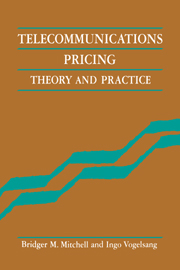Book contents
- Frontmatter
- Contents
- List of figures
- List of tables
- Acknowledgments
- I PRICING AND TELECOMMUNICATIONS
- II RECENT DEVELOPMENTS IN THE NORMATIVE ECONOMIC THEORY OF TARIFFS
- III TELEPHONE RATE STRUCTURES IN THE UNITED STATES
- IV SYNTHESIS
- A US telephone price indexes
- Bibliography
- Index
- Selected list of RAND books
A - US telephone price indexes
Published online by Cambridge University Press: 28 October 2009
- Frontmatter
- Contents
- List of figures
- List of tables
- Acknowledgments
- I PRICING AND TELECOMMUNICATIONS
- II RECENT DEVELOPMENTS IN THE NORMATIVE ECONOMIC THEORY OF TARIFFS
- III TELEPHONE RATE STRUCTURES IN THE UNITED STATES
- IV SYNTHESIS
- A US telephone price indexes
- Bibliography
- Index
- Selected list of RAND books
Summary
There are two primary sources of publicly available information regarding trends in the prices for US telecommunications services: the Bureau of Labor Statistics (BLS) telephone indexes, and the tariff filings associated with the price cap regulation of AT&Tapos;apos;s long-distance telephone services, which we have already described in Section 7.3. In this appendix we first examine the BLS indexes and then compare those data with the AT&T indexes. More technical details of the AT&T price cap formulas follow in the final section.
Bureau of Labor Statistics (BLS) price indexes
Price indexes and US experience
The United States government's Bureau of Labor Statistics (BLS) compiles statistics on the overall economy, with numerous subindexes devoted to specific sectors. The BLS maintains two different indexes which include price changes in domestic telecommunications services. The first is the Consumer Price Index (CPI), which reports changes in the prices of retail goods and services purchased by the typical consumer; the second is the Producer Price Index (PPI) which tracks trends in firms' sales prices. Both are chained Laspeyres indices that are infrequently reweighted; thus, they overstate the inflation which would be estimated by an ideal price index. Recent trends in these indexes are shown in Figure A.1.
Both indexes separate local and toll telephone services. In the United States, the domestic market is geographically divided into Local Access Transport Areas (LATAs) which in most cases correspond to metropolitan areas. With few exceptions, LATAs do not cross state lines.
- Type
- Chapter
- Information
- Telecommunications PricingTheory and Practice, pp. 264 - 286Publisher: Cambridge University PressPrint publication year: 1991



